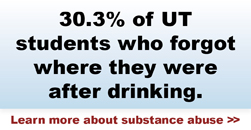Editor's Note: The Texas Commission on Alcohol and Drug Abuse estimates that addiction costs the state almost $26 billion annually—$16 billion of that due to alcoholism*.
And while the average age an individual enters recovery to address substance or alcohol abuse is 39, the patterns and habits that lead to addiction can start as early as high school and college. The University of Texas Center for Students in Recovery (UTSCR), housed within University Health Services, is one of 14 programs in the United States that support students in recovery and create a community to support choices for sobriety in college and beyond.
In this article, Ivana Grahovac, program coordinator for the UTCSR, discusses how UT is helping college students stay sober and avoid relapse during their college years and the impact those efforts have on Austin.
Forefront (FF): What does substance abuse typically look like on college campuses?
Ivana Grahovac (IG): It’s not always easy to measure substance abuse, since much of students’ behavior is self-reported, but high-risk drinking on college campuses is a big problem.
A spring 2010 survey of UT-Austin students reported that 14.9% of students who drank at a social event consumed seven or more drinks at that event. And within the past 12 months, 33.7% of students who drank reported doing something they later regretted, 30.3% forgot where they were or what they did, 16% had unprotected sex, and 14.2% injured themselves.
FF: Partying and experimentation has always been part of the college experience. Why is this such a big deal?
IG: A significant percentage of people who use drugs and alcohol in college are going to end up with dependency problems for the rest of their lives. The attitude of “it’s just college” is part of the problem. For a long time, these issues go unnoticed or get attributed to the normal college partying experience. But this behavior can cause immediate consequences for the community and long-term consequences for the individual.
FF: How does college-related substance abuse affect the rest of Austin?
IG: Students who abuse substances don’t just sit in their dorm rooms. They head out into the larger community. That spring 2010 survey of UT students I referenced earlier found that 4.6% of college students who drank in the last 30 days drove a car after having five or more drinks, and 35.5% got behind the wheel after having some amount of alcohol. Those students are driving on public roads, not just stumbling around campus.
And students commit other alcohol- and drug-fueled crimes. In 2000, the UT Police Department arrested 179 students for alcohol- and drug-related violations. By 2008, the number of those types of arrests increased to 464. Those arrest statistics and student behaviors are alarming, and there’s a true cost to society of these activities.
FF: What type of cost?
IG: Substance abuse costs money. In 2000, the Texas Commission on Alcohol and Drug Abuse estimated that addiction costs the state almost $26 billion annually. Much of that—$16 billion—is due to alcoholism. This is what substance abuse costs in terms of health care, lost productivity, wasted resources, and more.
FF: College kids aren’t responsible for all of that, are they?
IG: The behaviors formed in college have a huge impact on a person’s later life. The average person who enters recovery is about 48 years old. By that time, he’s done damage to his body, family, career, and community. College is a crucial time for forming a person’s character and future. If the only outlet someone has in college is partying and drinking, he’s missing a part of his development—he doesn’t see that being sober and substance-free is normal.
FF: What’s the impact of substance abuse on the students?
IG: Substance abuse and dependency don’t discriminate. You can have tremendous and gifted students who are on their way to doing incredible things for their families or even for society. But substance abuse snuffs out that promise. They may get arrested. They may get disowned by their families. They start on a path that many of them can’t change.
Dropping out of classes, losing opportunities, throwing away internships—I’ve seen it all. During my first week of work at UT, I had to attend a memorial for a student who died due to a drug overdose. The student was never aware that he could secure help for his addiction or have a chance of recovery.
FF: Why are college students at a high risk for developing a substance abuse problem?
IG: For adolescents and college students, drinking and doing drugs are great coping mechanisms. You can escape from stress or fit in with your peer group really easily. And that’s where dependency begins. When you enter college, it’s a very unstructured environment. You’re supposed to act like an adult but you want to have fun, and there’s a lot of increased responsibility.
College students experience life transitions and stresses that increase their risk of mental disorders, such as depression, anxiety, eating disorders, and substance abuse. These mental-health problems create serious challenges, as they interfere with a student’s ability to effectively cope. And students in recovery are also challenged by an environment that offers easy access to drugs and alcohol and a culture that promotes the misuse of substances. Substance-abuse disorders are also highly stigmatized. People think these conditions are caused by a moral deficiency or lack of willpower. So students don’t want to admit to needing help. In addition, denial is a very powerful mechanism that protects addictive behaviors.
FF: Are these problems starting in high school or college?
IG: A pre-matriculation survey conducted at UT in 2009 found that 39% of respondents were 15-17 years old when they first started drinking—really drinking, not just having a taste of Dad’s beer. And 30.9% of respondents reported being in the same age range when they got drunk for the first time.
Teenagers in Texas are also experimenting with drugs at alarming rates. Some get hooked, ruining their grades and occasionally getting in trouble with police. As an example, heroin addiction has increased dramatically in Texas. According to The Addiction Research Institute, since 2005 the number of teenagers admitted to Texas drug rehab because of heroin has jumped 61%. It’s not just heroin, though. The Office of National Drug Control Policy reports that one-third of Texas 10th graders have tried some type of illicit drug; almost 40% percent of Texas 12th graders have tried marijuana; and more than 10% of Texas 12th graders have experimented with cocaine or crack cocaine.
FF: What is the UT Center for Students in Recovery doing to help these students?
IG: We support students who come to UT already in recovery and help students who end up getting hooked while in college. We offer them access to a sober social network and peer group. And we help the broader community.
Students within the CSR keep each other accountable, organize sober social activities, mentor each other, and perform service work by volunteering to carry the message of recovery on campus and in the community. Students organize activities to promote sober lifestyles—parties, rock climbing, live music. It’s not just for people in recovery. We serve people who just don’t want to be confronted with alcohol and drugs at every event. We’re trying to create a different “normal,” one that doesn’t include alcohol and drugs.
FF: What else is needed to minimize the impact of substance abuse on students and the community?
IG: Community prevention efforts will continue to reduce substance-use-related accidents and crimes. However, I think that reducing the stigma of the recovery/sober lifestyle and organizing campus- and community-awareness initiatives as alternatives to “partying” will have long-term benefits.
Take Action

|














